
Trillium erectum, the red trillium, also known as wake robin, purple trillium, bethroot, or stinking benjamin, is a species of flowering plant in the family Melanthiaceae. The plant takes its common name "wake robin" by analogy with the European robin, which has a red breast heralding spring. Likewise Trillium erectum is a spring ephemeral plant whose life-cycle is synchronized with that of the forests in which it lives. It is native to the eastern United States and eastern Canada from northern Georgia to Quebec and New Brunswick.

Heracleum maximum, commonly known as cow parsnip, is the only member of the genus Heracleum native to North America. It is also known as American cow-parsnip, Satan celery, Indian celery, Indian rhubarb, poison turnip or pushki.

Kalmia is a genus of about ten species of evergreen shrubs from 0.2–5 m tall, in the family Ericaceae. They are native to North America and Cuba. They grow in acidic soils, with different species in wet acid bog habitats and dry, sandy soils.
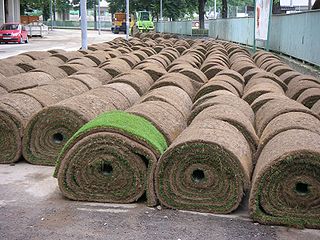
Sod, also known as turf, is the upper layer of soil with the grass growing on it that is often harvested into rolls.

Acer leucoderme is a deciduous tree native to the southeastern United States from North Carolina south to northwest Florida and west to eastern Texas. It lives in the understory in moist, rocky soils on river banks, ravines, woods, and cliffs. Although generally an uncommon tree, it is most often found in the inner coastal plain and Piedmont regions of Georgia.

Hibiscus grandiflorus, the large-flowered hibiscus or swamp rosemallow, is a species of flowering plant in the mallow family, Malvaceae. It Is native to the southern United States, from southeast Texas, to southern Florida as well as western Cuba. It is historically known from South Carolina. It favors wet habitats, especially tidal marshes, as well as lakeshores and wet pine savannas. Its flowers serve as a nectar source for hummingbirds, and its fruits provide seeds for other birds.

Cardamine concatenata, the cutleaved toothwort, crow's toes, pepper root or purple-flowered toothwort, is a flowering plant in the family Brassicaceae. It is a perennial woodland wildflower native to eastern North America.

Viola sororia, known commonly as the common blue violet, is a short-stemmed herbaceous perennial plant native to eastern North America. It is known by a number of common names, including common meadow violet, purple violet, woolly blue violet, hooded violet, and wood violet.

Nekemias arborea, commonly known as pepper vine, is native to the Southeastern United States, Texas, and New Mexico. It spreads rapidly, climbing up trees and bushes. It prefers moist soils such as stream banks, and disturbed areas.
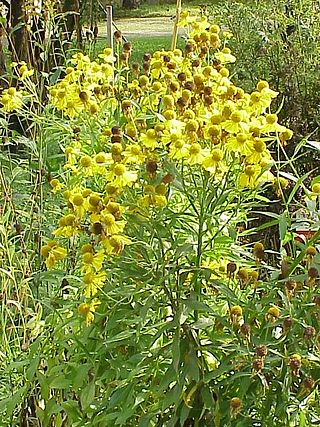
Helenium autumnale is a North American species of poisonous flowering plants in the family Asteraceae. Common names include common sneezeweed and large-flowered sneezeweed.

Syngonanthus is a genus of plant in family Eriocaulaceae. It is native to tropical Africa and to Latin America.

Opuntia humifusa, commonly known as the devil's-tongue, eastern prickly pear or Indian fig, is a cactus of the genus Opuntia present in parts of the eastern United States, Mississippi and northeastern Mexico.

Iris virginica, with the common name Virginia blueflag, Virginia iris, great blue flag, or southern blue flag, is a perennial species of flowering plant in the Iridaceae (iris) family, native to central and eastern North America.
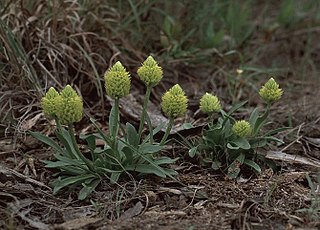
Polygala nana, commonly known as candyroot or low bachelors' buttons, is a small herbaceous plant native to the southeastern United States. The root has a sweet liquorice flavor when it is chewed, but it is usually hidden underground until the plant flowers. The seeds of candyroot are dispersed by ants.
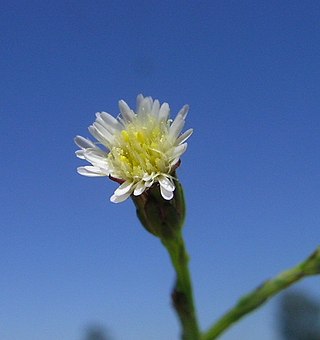
Symphyotrichum subulatum, commonly known as eastern annual saltmarsh aster or, in Britain and Ireland where it is naturalized, annual saltmarsh aster, is an annual plant in the family Asteraceae native to the eastern United States and the Gulf Coast to Texas. The species grows primarily in coastal salt marshes, although in the Ozarks it occurs as a non-marine weedy variety.

Hypericum frondosum, the cedarglade St. Johnswort or golden St. John's wort, is a species of flowering plant in the St. John's wort family, Hypericaceae. It is native to the central and southeastern United States in dry, rocky habitats.
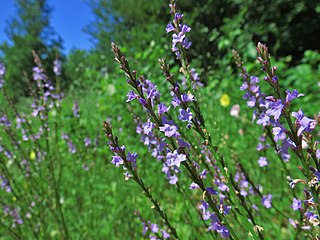
Verbena halei, commonly known as Texas vervain, Texas verbena, or slender verbena, is a flowering plant in the vervain family, Verbenaceae. It is native to much of the southern United States and Mexico. Scattered populations have been found along the east coast, and its range stretches south to Florida, west to Arizona, and throughout most of Mexico. It is a perennial shrub and grows in thickets and woodland borders. Flowers bloom March to June. It has been introduced to Australia, in Queensland, New South Wales, Victoria, and South Australia.

Physalis walteri, commonly known as Walter's groundcherry or dune groundcherry, is a species of flowering plant. Its native distribution is Alabama, Florida, Georgia and Virginia in the United States as well as Northeast Mexico. Its habitat is pinelands and open coastal areas.

Carex tenax, the wire sedge, is a species of flowering plant in the family Cyperaceae, native to Texas and the southeastern United States.
Zephyranthes simpsonii, known by a number of common names including redmargin zephyr-lily, Simpson's zephyr-lily and Simpson's rain-lily, is a geophytic perennial herb that grows up to 10 inches tall. It is found from the southeastern United States.



















